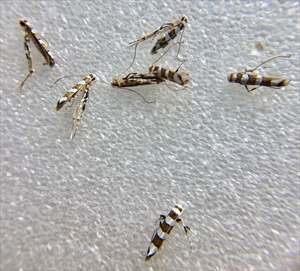There is no common name. Here it is called the bele (the local name in Fiji) leafminer.
Pacific Pests, Pathogens, Weeds & Pesticides - Online edition
Pacific Pests, Pathogens, Weeds & Pesticides
Bele (Abelmoschus) leafminer (256)
Acrocercops patellata, a member of the Gracillariidae family. Acrocercops cathedrae is recorded on aibeka (the local name for Abelmoschus manihot) from Papua New Guinea1.
World distribution unknown. Acrocercops species on bele are recorded from Fiji and Samoa. Acrocercops patellata is recorded from Indonesia.
Bele. Swaine (1971)2, in Fiji, records Acrocercops species from bele (Abelmoschus manihot), okra (Abelmoschus esculentus), and other members of the mallows (Malvaceae family, including the cultivated Hibiscus rosa-sinensis and the wild Hibiscus tiliaceus. Acrocercops patellata was bred from bele and Malay apple, Syzygium malaccense, for this fact sheet.
The larvae cause extensive mining over large areas of the leaf (Photo 1&2). The mines often run alongside the veins at first. The damaged areas become paper-thin, bronzed and shiny.
The adult moth is about 4 mm long; wings are brown with three white bands across them with black borders. The head is covered with silver scales. The young larvae are yellow; the mature larvae are red and 5 mm long. Pupation occurs in white cocoons in folds of leaves on weeds (broadleaved or grass) beneath the bele plants.
An important pest of bele and okra that is widely found in Fiji. Leaves that are mined are unlikely to be plucked for household use or sale in the market.
Look for the brown mines, most obvious on the topside of the leaves, often alongside veins, bordered by irregular paper-thin silvery areas, turning bronzed with age. Look for the damaged patches throughout the leaf rendering the leaves useless for household or market use.
CULTURAL CONTROL
During growth:
- Squash the mines between finger and thumb to kill the larvae if the number of mines is small. Do this as soon as the mines are seen.
- If the number of mines is too large to squash, remove the infested leaves with mines, as soon as they are seen, and burn them.
- Do not plant new gardens next to those with leafminer damage.
After harvest:
- When plants come to the end of their usefulness, pull them out and burn them. Do not leave the plants, otherwise the leafminers will continue to breed on the few remaining leaves and infect nearby healthy plants.
RESISTANT VARIETIES
Differences between varieties has not been reported but it is worth checking if the narrow leaf varieties suffer less damage than those with broad leaves.
CHEMICAL CONTROL
Chemical control is difficult because the larvae are protected inside their mines, and pupae develop on weeds, not on bele. Also, insecticides are likely to destroy natural enemies, and this can lead to outbreaks of other insects, and also mites.
- However, if pesticides are required, use white oil (made from vegetable oils), soap solution, or horticultural oil (made from petroleum) (see Fact Sheet no. 56).
- White oil:
- 3 tablespoons (1/3 cup) cooking oil in 4 litres water
- ½ teaspoon pure hand soap, not detergent
- Shake well and use.
- Soap:
- Use soap (pure hand soap, not detergent):
- 5 tablespoons of soap in 4 litres water.
- White oil:
- Commercial horticultural oil can also be used. White oil, soap and horticultural oil sprays work by blocking the breathing holes of insects causing suffocation and death. Spray the undersides of leaves; the oils must contact the insects. A second application of soap or oils may be necessary after 3-4 weeks. It is important to test whether soap, white oil or horticultural oil damage leaves by spraying a single plant before spraying the rest.
Alternatively, use:
- Plant-derived products (PDPs; see Fact Sheet no. 56), such as neem, derris, pyrethrum and chilli (with the addition of soap). PDPs are useful here as they are usually broken down by sunlight within 3 days of application.
- Synthetic pyrethroids are likely to be effective against leafminers, as are systemic products such as acephate or imidacloprid.
- If any of these synthetic pesticides are used, it is important to follow the instructions on the label, especially the with-holding period; this is the number of days between last the application of the spray and the harvest of the leaves.
--------------------
Note, derris (Derris species) contains rotenone, an insecticide, often used as a fish poison; it should be used with caution. The commercial derris insecticide is made from Derris elliptica.
____________________
When using a pesticide, always wear protective clothing and follow the instructions on the product label, such as dosage, timing of application, and pre-harvest interval. Recommendations will vary with the crop and system of cultivation. Expert advice on the most appropriate pesticides to use should always be sought from local agricultural authorities.
AUTHORS Grahame Jackson and Mani Mua
1Preston SR (1998) Aibika/Bele. Abelmoschus manihot (L.) Medik. Promoting the conservation and use of underutilized and neglected crops. 24. Institute of Plant Genetics and Crop Plant Research, Gatersleben/International Plant Genetic Resources Institute, Rome; and 2Swaine G (1971) Agricultural Zoology in Fiji. Her Majesty's Stationery Office. London, HMSO; and from van Haren MM The leafblotch miners moths (Lepidoptera: Gracillariidae: Gracillariinae) of Papua Indonesia (https://www.papua-insects.nl/insect%20orders/Lepidoptera/Gracillariidae/Acrocercops/Acrocercops%20patellata.htm).
Produced with support from the Australian Centre for International Agricultural Research under project PC/2010/090: Strengthening integrated crop management research in the Pacific Islands in support of sustainable intensification of high-value crop production, implemented by the University of Queensland and the Secretariat of the Pacific Community.







